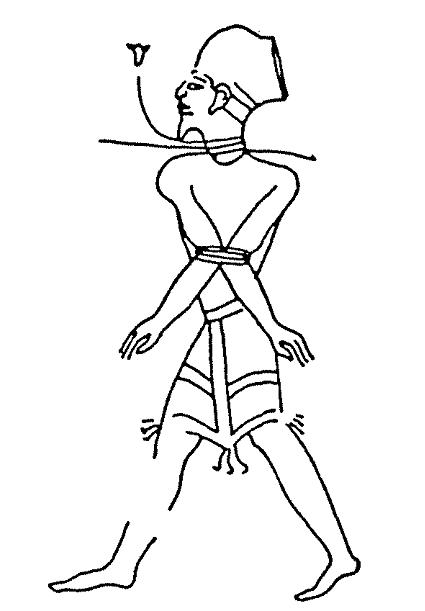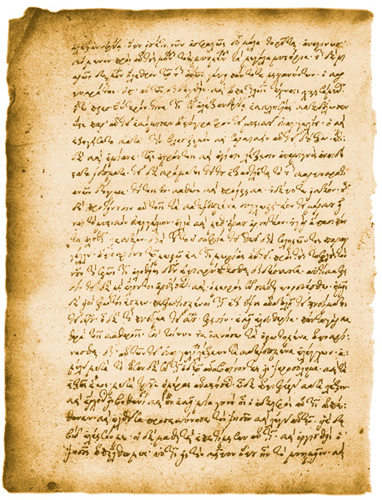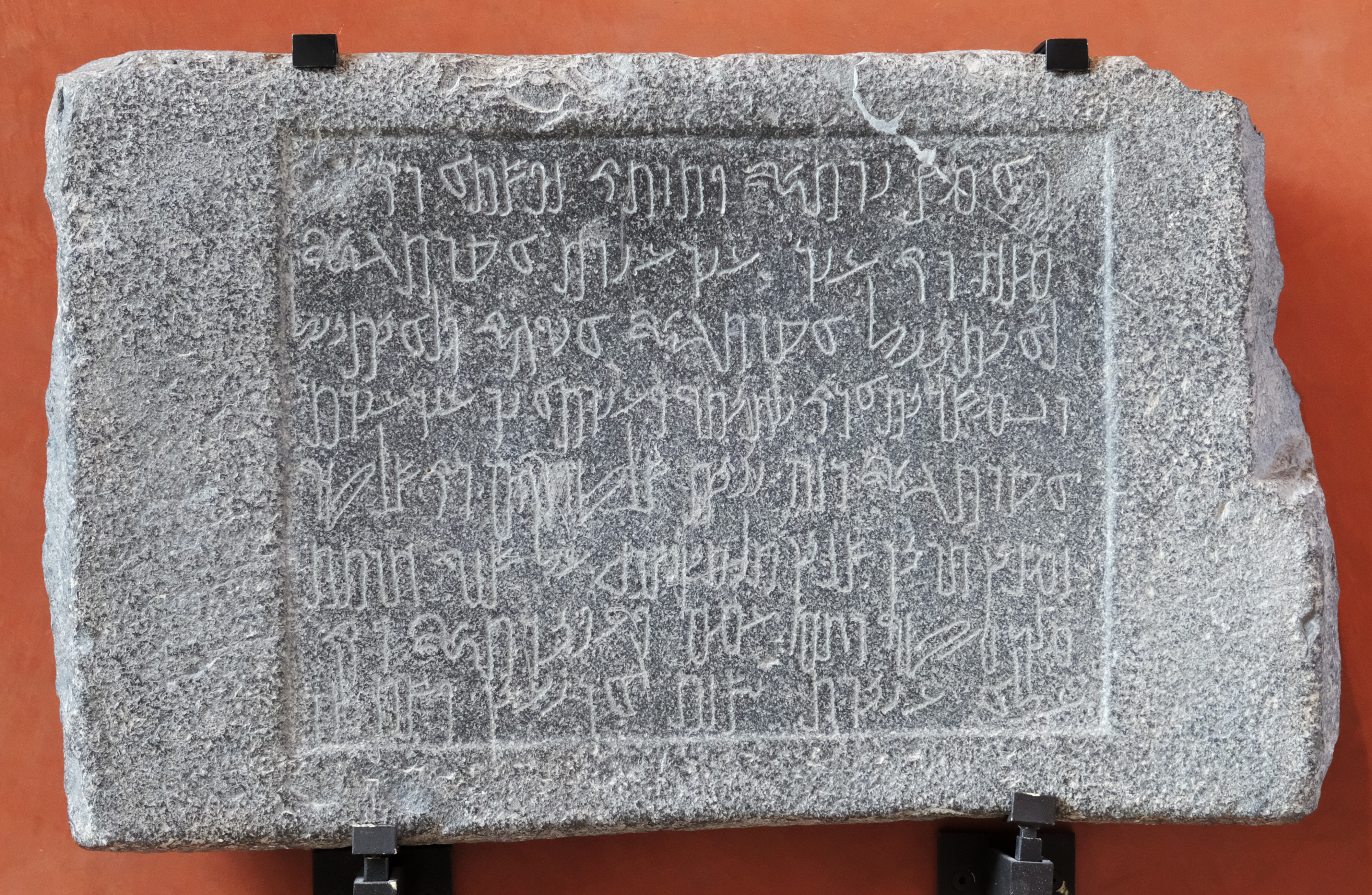|
Qaus
Qos (Edomite: 𐤒𐤅𐤎 ''Qāws'', later ''Qôs''; Hebrew: ''Qōs'')Lévi Ngangura Manyanya. (2009)La fraternité de Jacob et d'Esaü (Gn 25-36): quel frère aîné pour Jacob?''Labor et Fides'', p.257. also Qaus ( akk, 𒋡𒍑 ''Qa-uš''), or Koze (Greek: Kωζαι ''Kōzai'') was the national god of the Edomites. He was the Idumean structural parallel to Yahweh. The name occurs only twice in the Old Testament (if a possible allusion in an otherwise corrupted text in the Book of Proverbs is excluded) in the Book of Ezra and Nehemiah as an element in a personal name, ''Barqos'' ("son of Qos", compare the Hebrew " Benaiah" meaning "son of Jah"), referring to the 'father' of a family or clan of perhaps Edomite/Idumaean ''nəṯīnīm'' or temple helpers returning from the Babylonian exile.E. A. Knauf. (1999). Qos nKarel van der Toorn, Bob Becking, Pieter Willem van der Horst ds.br>''Dictionary of Deities and Demons in the Bible'' pp.674-677. Wm. B. Eerdmans Publishing: “Th ... [...More Info...] [...Related Items...] OR: [Wikipedia] [Google] [Baidu] |
Idumea
Edom (; Edomite: ; he, אֱדוֹם , lit.: "red"; Akkadian: , ; Ancient Egyptian: ) was an ancient kingdom in Transjordan, located between Moab to the northeast, the Arabah to the west, and the Arabian Desert to the south and east.Negev & Gibson (ed.), 2001, ''Edom; Edomites'', pp. 149–150 Most of its former territory is now divided between present-day southern Israel and Jordan. Edom appears in written sources relating to the late Bronze Age and to the Iron Age in the Levant. Edomites are related in several ancient sources including the Tanakh, a list of the Egyptian pharaoh Seti I from c. 1215 BC as well as in the chronicle of a campaign by Ramesses III (r. 1186–1155 BC). Archaeological investigation has shown that the nation flourished between the 13th and the 8th century BC and was destroyed after a period of decline in the 6th century BC by the Babylonians. After the fall of the kingdom of Edom, the Edomites were pushed westward towards southern Judah by ... [...More Info...] [...Related Items...] OR: [Wikipedia] [Google] [Baidu] |
Edom
Edom (; Edomite: ; he, אֱדוֹם , lit.: "red"; Akkadian: , ; Ancient Egyptian: ) was an ancient kingdom in Transjordan, located between Moab to the northeast, the Arabah to the west, and the Arabian Desert to the south and east.Negev & Gibson (ed.), 2001, ''Edom; Edomites'', pp. 149–150 Most of its former territory is now divided between present-day southern Israel and Jordan. Edom appears in written sources relating to the late Bronze Age and to the Iron Age in the Levant. Edomites are related in several ancient sources including the Tanakh, a list of the Egyptian pharaoh Seti I from c. 1215 BC as well as in the chronicle of a campaign by Ramesses III (r. 1186–1155 BC). Archaeological investigation has shown that the nation flourished between the 13th and the 8th century BC and was destroyed after a period of decline in the 6th century BC by the Babylonians. After the fall of the kingdom of Edom, the Edomites were pushed westward towards southern Judah by ... [...More Info...] [...Related Items...] OR: [Wikipedia] [Google] [Baidu] |
Kaus-malaka
Ḳaus-malaka (Akkadian: 𒋡𒍑𒈠𒆷𒅗 ''Qauš-malaka''; Edomite: 𐤒𐤅𐤎𐤌𐤋𐤊 ''Qāws-melek'' or ''Qāws-malāk'') was the king of Udumi (Edom) during the reign of the Assyrian king Tiglath-Pileser III. His name can either mean "Qaus Qos (Edomite: 𐤒𐤅𐤎 ''Qāws'', later ''Qôs''; Hebrew: ''Qōs'')Lévi Ngangura Manyanya. (2009)La fraternité de Jacob et d'Esaü (Gn 25-36): quel frère aîné pour Jacob?''Labor et Fides'', p.257. also Qaus ( akk, 𒋡𒍑 ''Qa-uš''), or ... is king" (-''melek'') or "Qaus rules" (-''malek''). References Kings of Edom 7th-century BC people {{MEast-royal-stub ... [...More Info...] [...Related Items...] OR: [Wikipedia] [Google] [Baidu] |
Yahweh
Yahweh *''Yahwe'', was the national god of ancient Israel and Judah. The origins of his worship reach at least to the early Iron Age, and likely to the Late Bronze Age if not somewhat earlier, and in the oldest biblical literature he possesses attributes typically ascribed to weather and war deities, fructifying the land and leading the heavenly army against Israel's enemies. The early Israelites were polytheistic and worshipped Yahweh alongside a variety of Canaanite gods and goddesses, including El, Asherah and Baal. In later centuries, El and Yahweh became conflated and El-linked epithets such as El Shaddai came to be applied to Yahweh alone, and other gods and goddesses such as Baal and Asherah were absorbed into Yahwist religion. Towards the end of the Babylonian captivity, the very existence of foreign gods was denied, and Yahweh was proclaimed as the creator of the cosmos and the one true God of all the world, giving birth to Judaism, which has 14–15 mill ... [...More Info...] [...Related Items...] OR: [Wikipedia] [Google] [Baidu] |
Herod The Great
Herod I (; ; grc-gre, ; c. 72 – 4 or 1 BCE), also known as Herod the Great, was a Roman Jewish client king of Judea, referred to as the Herodian kingdom. He is known for his colossal building projects throughout Judea, including his renovation of the Second Temple in Jerusalem and the expansion of the Temple Mount towards its north, the enclosure around the Cave of the Patriarchs in Hebron, the construction of the port at Caesarea Maritima, the fortress at Masada, and Herodium. Vital details of his life are recorded in the works of the 1st century CE Roman–Jewish historian Josephus. Herod also appears in the Christian Gospel of Matthew as the ruler of Judea who orders the Massacre of the Innocents at the time of the birth of Jesus, although most Herod biographers do not believe that this event occurred. Despite his successes, including singlehandedly forging a new aristocracy from practically nothing, he has still been criticised by various historians. His reign pola ... [...More Info...] [...Related Items...] OR: [Wikipedia] [Google] [Baidu] |
Shasu
The Shasu ( from Egyptian ''šꜣsw'', probably pronounced ''Shasw'') were Semitic-speaking cattle nomads in the Southern Levant from the late Bronze Age to the Early Iron Age or the Third Intermediate Period of Egypt. They were organized in clans under a tribal chieftain, and were described as brigands active from the Jezreel Valley to Ashkelon and the Sinai. Some scholars link the Israelites and YHWH with the Shasu. Etymology The name's etymon may be Egyptian ''šꜣsw'', which originally meant "those who move on foot". Levy, Adams, and Muniz report similar possibilities: an Egyptian word that means "to wander", and an alternative Semitic one with the meaning "to plunder". History The earliest known reference to the Shasu occurs in a 15th-century BCE list of peoples in the Transjordan region. The name appears in a list of Egypt's enemies inscribed on column bases at the temple of Soleb built by Amenhotep III. Copied later in the 13th century BCE either by Seti I or by Rames ... [...More Info...] [...Related Items...] OR: [Wikipedia] [Google] [Baidu] |
Morton Smith
Morton Smith (May 28, 1915 – July 11, 1991)Neusner, Jacob, ''Christianity, Judaism, and other Greco-Roman Cults. Part 1: New Testament'', ed. J. Neusner, ''Studies for Morton Smith at Sixty, vol 1, New Testament'' (Leiden: E.J. Brill, 1975), p. ix.Calder III, William M. “Smith, Morton”, in ''Biographical Dictionary of North American Classicists'', Ward W. Briggs, Jr., (ed.) (Westport, CT: Greenwood Press, 1994), p. 600. was an American professor of ancient history at Columbia University. He is best known for his reported discovery of the Mar Saba letter, a letter attributed to Clement of Alexandria containing excerpts from a Secret Gospel of Mark, during a visit to the monastery at Mar Saba in 1958. This letter fragment has had many names, from ''The Secret Gospel'' through ''The Mar Saba Fragment'' and the ''Theodoros''. Biography Smith was born in Philadelphia on May 28, 1915. He received his bachelor's degrees from Harvard College and the Harvard Divinity School, a Ph.D. ... [...More Info...] [...Related Items...] OR: [Wikipedia] [Google] [Baidu] |
Costobarus
Costobarus (Greek: Κοστόβαρος) was an associate of Herod the Great (who made Costobarus governor of Idumea) and second husband of Herod's sister Salome I. He was also known as Costobar.{{cite book, last1=Flavius, first1=Josephus (93 CE), last2=Marcus, first2=Ralph ranslatorlast3=Wikgren, first3=Allen ranslatortitle=Jewish Antiquities., date=1990, publisher=Harvard University Press, location=Cambridge, Massachusetts, isbn=0-674-99451-5, edition=Loeb Classical Library Another member of the Herodian dynasty was Costobar, who was the brother of Saul. Both Saul and Costobar were likely grandsons of Costobarus. Costobar(us), husband of Salome Costobarus was an associate of Herod during the latter’s rise to power. Following the capitulation of Jerusalem in 37 BC during the campaign by Mark Antony and Herod against the Hasmonean king Antigonus II - Costobar controlled the exits from the city.Josephus “Antiquities” xv: 260-266 Around this time, Antony appointed Herod a ... [...More Info...] [...Related Items...] OR: [Wikipedia] [Google] [Baidu] |
Khirbet Et-Tannur
Khirbet et-Tannur (Arabic: خربة التنور) is an ancient Nabataean temple situated on top of Jebel Tannur, in today's Jordan. Based on the cults statues iconography, whether the temple was dedicated to the fertility goddess Atargatis and Zeus-Hadad, or perhaps other gods of their own in that form is not yet certain. The only inscription which mentioned a deity was in reference to the Edomite god Qos, who was the equivalent of the Arab god Quzah, the god of the sky. History The remains of Khirbet et-Tannur consists only of the temple complex on isolated mountain top, which indicate a site solely functioning as a religious high place similar to those in other Nabataean regions. While no dating is established, the temple went through three different phases. The earliest phase of the temple is usually dated around 8-7 BC on the account of an inscription engraved on a small stone block. The final phase was dated by Glueck judging from the temple's sculptures and architectural ... [...More Info...] [...Related Items...] OR: [Wikipedia] [Google] [Baidu] |
Cleopatra
Cleopatra VII Philopator ( grc-gre, Κλεοπάτρα Φιλοπάτωρ}, "Cleopatra the father-beloved"; 69 BC10 August 30 BC) was Queen of the Ptolemaic Kingdom of Egypt from 51 to 30 BC, and its last active ruler.She was also a diplomat, naval commander, linguist, and medical author; see and . A member of the Ptolemaic dynasty, she was a descendant of its founder Ptolemy I Soter, a Macedonian Greek general and companion of Alexander the Great. writes about Ptolemy I Soter: "The Ptolemaic dynasty, of which Cleopatra was the last representative, was founded at the end of the fourth century BC. The Ptolemies were not of Egyptian extraction, but stemmed from Ptolemy Soter, a Macedonian Greek in the entourage of Alexander the Great."For additional sources that describe the Ptolemaic dynasty as " Macedonian Greek", please see , , , and . Alternatively, describes them as a "Macedonian, Greek-speaking" dynasty. Other sources such as and describe the Ptolemies a ... [...More Info...] [...Related Items...] OR: [Wikipedia] [Google] [Baidu] |
Nabataean Aramaic
Nabataean Aramaic is the Aramaic variety used in inscriptions by the Nabataeans of the East Bank of the Jordan River, the Negev, and the Sinai Peninsula. Compared to other varieties of Aramaic, it is notable for the occurrence of a number of loanwords and grammatical borrowings from Arabic or other North Arabian languages.Butts, Aaron M"North Arabian Features in the Nabataean Aramaic Inscriptions from Madāʼin Ṣāliḥ: A Contact-Linguistic Analysis" in G.J. Brooke et al. (eds), ''Near Eastern and Arabian Essays: Studies in Honour of John F. Healey'' (Journal of Semitic Studies Supplement 41; Oxford: Oxford University Press), 39–57. Attested in several dozen longer dedicatory and funerary inscriptions and a few legal documents from the period of the Nabataean Kingdom, Nabataean Aramaic remained in use for several centuries after the kingdom's annexation by the Roman Empire in 106 AD. Over time, the distinctive Nabataean script was increasingly used to write texts in the Arab ... [...More Info...] [...Related Items...] OR: [Wikipedia] [Google] [Baidu] |









